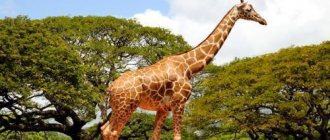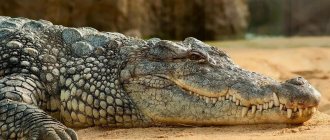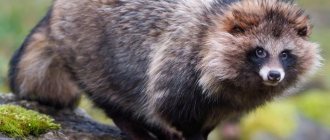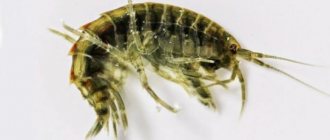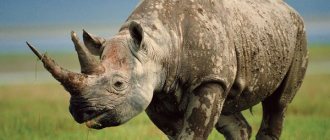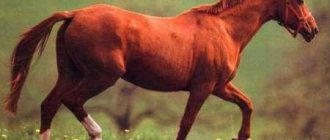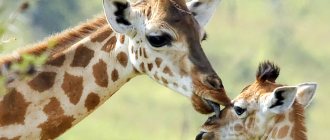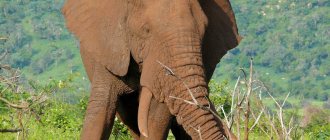Rhinoceroses
(lat. Rhinocerotclassae) - large mammals, are representatives of the equid family. Thick gray skin, with virtually no hair, covers the outside of the body. The legs are equipped with three toes, on which there are small hooves. Only 5 species have survived to this day.
The habitat of three of them is limited to Asia. Two more species - the white rhinoceros and the black rhinoceros - occupy the territory of Western and Central Africa; they separated five million years ago. The largest number of individuals belongs to Indian rhinoceroses. The famous rhinoceros horn is represented by a layered formation of keratin.
The paleontological history of the rhinoceros family is quite complex. The ancestors of these animals were the running rhinoceroses of America from the early Tertiary group, which are comparable to ancient horses. Their build could be either light or heavy (rhinos with short legs). Rhinoceroses of the modern species appeared in the Eocene, and by the Oligocene they were represented by a large number of genera and species. At that time, rhinoceroses widely inhabited Eurasia.
Spring is the time for marriage between rhinoceroses
Male rhinos even engage in fights - this is how they fight for a female who is ready to mate. The cub is carried by the female for a whole year and a half! Compared to the weight of an adult rhinoceros, babies are born very tiny. Indian rhinoceroses, for example, weigh only 60 kilograms. The next day after birth, a small rhinoceros can already follow its mother, and two weeks later it can graze on its own. But for another whole year, his main food supply will be mother's milk. The cub lives with its mother for about two and a half years. If suddenly another cub appears during these years, the older one is expelled, if not forever, then for a while.
Tapir genus
Mountain tapir
The mountain tapir is the second largest species of tapir. The body length of representatives of this species can reach 1.8 m, while they grow up to 80 cm in height. On average, an adult animal weighs about 130-150 kg. Tapirs have pronounced sexual dysmorphism, that is, females are somewhat larger than males.
The body of tapirs is quite bulky, the legs are thin. The front paws have 4 toes, while the hind paws have only 3. At the end of the muzzle there is a characteristic trunk. The difference between the mountain tapir and other species is that it has a coat of fur on its body that protects it from low temperatures.
Brazilian (lowland) tapir
The body length of the lowland tapir reaches an average of 220 cm, and body weight is from 150 to 270 kg. Males, as is the case with mountain tapirs, are smaller than females. The lifespan of an animal in the wild is 25-30 years; in captivity, tapirs live longer, about 35 years.
It is more of a nocturnal animal than a diurnal one. At night, tapirs go out in search of leaves, fruits and algae (the main diet of tapirs), and during the day they hide in the thickets. Plains tapirs are very timid and will flee at the slightest sign of danger.
Central American tapir
The Central American tapir, also known as Baird's tapir, is a rare animal listed in the IUCN Red Book. The total number of this species in nature is already around 5,000 individuals. The main reason for the extinction of the Central American tapir is the massive deforestation of tropical forests in Central America. In the 20th century alone, the total forest area was reduced by 70%. It is not surprising that the animal, for which the forests of Central America were the main habitat, suffered greatly from this.
Externally, Baird's tapir is somewhat reminiscent of the lowland tapir, but it is somewhat larger and has a shorter occipital mane. Like other types of tapirs, it is a very shy nocturnal animal.
Malayan tapir
The Malayan tapir, also known as the black-backed tapir, is the largest of its kind. The body length of the Malayan tapir reaches 2.5 m, and body weight up to 300 kg. The coloring of this species is unusual - black and white. Young tapirs, like other tapir species, are striped when young. Only by 5 months of age do the stripes disappear and the animal acquires a black and white color.
Like other species, the Malayan is a very fearful animal. They prefer a nocturnal lifestyle, and during the day they hide in bushes.
Rhinos have friends
First, there are buffalo birds. The size of these birds, which are very widespread in Africa, is comparable to the size of a starling. They destroy blood-sucking insects that have burrowed into the skin of rhinoceroses. Buffalo birds not only relentlessly follow the rhinoceroses, but also warn their feeders of impending danger. Second helpers are water turtles that live in local mud baths. By feeding on the above-mentioned insects, they make life much easier for rhinoceroses. Moreover, these turtles are not afraid of such a huge size of a rhinoceros - as soon as he lowers himself into the bath, they immediately get down to business!
Range, habitats
Black rhinoceroses are typical inhabitants of dry landscapes, tied to a specific habitat area that does not leave throughout their lives. The most numerous subspecies, D. bicornis minor, inhabits the southeastern part of its range, including Tanzania, Zambia, Mozambique and the northeastern part of South Africa. The type subspecies D. bicornis bicornis is an adherent of the drier regions of the southwest and northeast of its range in Namibia, South Africa and Angola, and the eastern subspecies D. bicornis michaeli is found mainly in Tanzania.
The distribution range of the white rhinoceros is represented by two areas remote from each other. The first (southern subspecies) lives in South Africa, Namibia, Mozambique and Zimbabwe. The habitat of the northern subspecies is represented by the northern and northeastern regions of the Democratic Republic of the Congo and South Sudan.
The Indian rhinoceros spends most of its time alone, in an individual area. Currently found exclusively in southern Pakistan, Nepal and eastern India, a small number of animals remain in the northern territories of Bangladesh.
Everywhere, with rare exceptions, representatives of the species live in strictly protected and sufficient areas. The Indian rhinoceros is a very good swimmer, so there are cases when such a large animal swam across the wide Brahmaputra.
Previously, representatives of the Sumatran rhinoceros species inhabited tropical rainforests and swampy areas in Assam, Bhutan, Bangladesh, Myanmar, Laos, Thailand, Malaysia, and were also found in China and Indonesia. Today, Sumatran rhinos are on the verge of extinction, with only six viable populations remaining in Sumatra, Borneo and the Malay Peninsula.
This is interesting! Rhinoceroses that live alone may well tolerate their relatives at watering holes, but in an individual area they always show intolerance and get involved in fights. However, rhinoceroses of one herd, on the contrary, protect members of the clan and are even able to help their wounded brothers.
The typical habitats of the Javan rhinoceros are tropical lowland forests, as well as wet grasslands and river floodplains. Some time ago, the distribution area of this species included the entire mainland of Southeast Asia, the territory of the Greater Sunda Islands, the southeastern part of India and the extreme zones of southern China. Today, the animal can be seen exclusively in the Ujung-Kulon National Park.
Return to content
Different types of rhinoceroses have different personalities
For example, black rhinoceroses are seriously hot-tempered. In general, rhinoceroses are timid animals; they avoid closeness to humans. If such a rhinoceros accidentally stumbles upon something and considers it something dangerous, it will immediately rush towards it. True, myopia does not allow them to launch attacks clearly on the target. But the sharp horn of these animals can easily lead to injury. But it is impossible to stop rhinoceroses - with such weight they can accelerate to forty-five kilometers per hour! White rhinoceroses are more peaceful in nature. And if you take them to the zoo at a young age, they generally become tame and love to be petted.
Genus Rhinoceros
Sumatran rhinoceros
Sumatran rhinoceroses are the smallest of the Asian rhinoceros species and have 2 horns. The body of Sumatran rhinoceroses is covered with long hair, the ears are fringed, and the skin is reddish-brown in color.
An adult Sumatran rhinoceros typically reaches a length of 2-4 meters, a height of 1-1.5 meters, and a body weight of 600 to 1 ton. As for the horn, the front one is longer, about 25-80 cm, and the back one is very short, less than 10 cm.
Female Sumatran rhinoceroses reach sexual maturity at 6-7 years of age, while males only reach maturity at 10 years of age. Like other species of rhinoceros, the life expectancy of the Sumatran rhinoceros reaches 35-40 years.
Indian rhinoceros
The Indian rhinoceros is a huge animal that can have a body weight of more than 2.5 tons. Indian rhinoceroses reach a height of 200 cm. Females are significantly smaller than males in size. On average, the length of the horn in males is no shorter than 25 cm and sometimes reaches 60 cm. In females, the horn is practically absent; instead, there is a formation on the nose that very much resembles a bump.
The skin of this species is bare, gray in color. Although the original color of the animal is very difficult to distinguish, since rhinoceroses are constantly covered with a layer of mud, in which they love to wallow.
Despite the fact that due to its large dimensions the animal seems clumsy, in reality this is far from the case. The Indian rhinoceros has good reflexes and can reach speeds of up to 40 km/h. In addition, he has a well-developed sense of smell. Like other rhino species, this one also suffers from vision problems.
Javan rhinoceros
The Javan rhinoceros is one of the rarest large mammals in the world. Today, the population of this animal has dropped to 50 individuals in the wild.
This rhinoceros is very similar to the Indian one, but somewhat smaller.
The Javan rhinoceros has only one horn, about 25 cm long. In females, the horn is either completely absent or has a rather small size.
We also recommend reading: List of artiodactyl animals
This species of rhinoceros prefers a solitary lifestyle. Only male and female meet in pairs during the mating season, as well as females who have offspring. The average life expectancy of a Javan rhinoceros is 30-40 years.
Black rhinoceros
Black rhinoceroses are quite large animals. Their body weight can reach 2 tons, and their length can be up to 3 meters. Two fairly massive horns are clearly visible on the head.
Despite the name “black,” the skin of a rhinoceros is not black at all, but gray.
White rhinoceros
The white rhinoceros is one of the largest rhinoceroses. Male white rhinoceros can weigh up to 3.6 tons, and females up to 1.7 tons. As with the black rhinoceros, the name “white” does not mean that this rhinoceros has white skin color. Its color can vary from gray to yellow-brown.
Rhinoceroses have the most complex social structure. In the fight for the female, rhinoceroses use their horn, inflicting serious wounds on the enemy, which often lead to death. In addition, the female, who is in the territory of the male, does not have the right to go beyond the boundaries of his territory.
Artiodactyls
In biology, the artiodactyl order is classified as placental mammals and is divided into ruminants, non-ruminants and calloseds. Mostly representatives of the order are herbivores, some, for example, pigs, duikers, and deer, are omnivores.
They live on all continents except Antarctica. Only hippos are semi-aquatic; the rest live on land. Most animals of the artiodactyl order run fast. They move strictly parallel to the ground, so they lack collarbones.
They are rarely “loners”, usually uniting in herds. For the most part, artiodactyls are nomads. They do not stay in one place for long, do not build burrows and shelters, but constantly move in search of food. They are characterized by seasonal migrations.
Interestingly, their distant relatives are whales. Once upon a time, these huge sea creatures already came onto land, and even had a common ancestor with modern hippopotamuses. The semi-aquatic lifestyle has changed them so much that they more closely resemble fish to us. However, smart scientists have long solved this puzzle and united the two orders into the group of cetaceans.
What are hooves for?
The presence of a hoof is the main defining feature of artiodactyls and odd-toed ungulates. These are horny “cases” covering the phalanges of animals’ fingers. In essence, it is highly compacted and modified skin, the epidermis of which has turned into a callus.
They are necessary for shock absorption and to prevent damage to the limbs. “Horny capsules” or “shoes” are not just appendages. They are connected to blood vessels and increase blood flow to the fingers during active movement.
The hooves of different species varied depending on the nature of the soil. Thus, in animals inhabiting environments with soft soil, the horny sheath is wide and large. Inhabitants of rocky and rocky areas have narrow and small hooves.
They bear the entire weight of the animal, and it is distributed unevenly, which is why some of the fingers have become shorter. In equids, the third digit is best developed. The rest can be shortened (in the horse they have disappeared completely). In mammals of the artiodactyl order, the third and fourth fingers are well developed. The first is reduced, and the second and fifth are greatly shortened and underdeveloped.
Natural enemies
Young animals of any species in rare cases become victims of the largest predators belonging to the cat family: tigers, lions, cheetahs. Adult rhinoceroses have no enemies other than humans. It is humans who are the main reason for the sharp decline in the natural population of such equid mammals.
In Asia, to this day there is a very high demand for rhinoceros horns, which are used to make precious items and are actively used in Chinese traditional medicine. Medicines made from rhinoceros horn are not only highly valued, but are also included in elixirs of “immortality” or longevity. The existence of this market has caused the threat of extinction of rhinoceroses, and dried horns are still used to get rid of:
- arthritis;
- asthma;
- chicken pox;
- seizures;
- cough;
- demonic possession and madness;
- diphtheria;
- dog, scorpion and snake bites;
- dysentery;
- epilepsy and fainting;
- fever;
- food poisoning;
- hallucinations;
- headaches;
- hemorrhoids and rectal bleeding;
- impotence;
- laryngitis;
- malaria;
- measles;
- memory loss;
- myopia and night blindness;
- nightmares;
- plague and polio;
- toothache;
- worms and uncontrollable vomiting.
This is interesting! The World Wildlife Fund (WWF) established Rhino Day in 2010, which has since been celebrated annually on September 22.
In addition to poaching, which is widespread in many countries, the destruction of their natural habitat as a result of intensive agricultural activities has a huge impact on the rapid extinction of these animals. Even-toed ungulate mammals survive from their distribution areas and are not able to find a worthy replacement for the abandoned territories.
Return to content
Ruminants
Most of the species from the order Artiodactyla belong to the ruminants. In structure, these are, as a rule, slender animals capable of inhabiting both lowland steppes and high mountain ranges.
They include large and small livestock (goats, cows, sheep, yaks, buffaloes), as well as deer, giraffes, bison, bison, elk, etc. Many have thick fur and two horns on their heads.
Ruminants have a special digestive system. Their four-chambered stomach does not immediately pass food into the intestines. Passing through the first two sections, food is belched back into the oral cavity. There it is thoroughly moistened with saliva and ground, and then sent to the remaining chambers of the stomach.
Ruminants lack upper incisors and canines. In place of these teeth is a callous plate that helps the lower teeth cut grass. The front and side teeth are separated by a large gap. But the family of deer and musk deer have upper canines. They resemble tusks and reach up to seven centimeters in length. They need fangs for defense, catching small mammals and fish.

